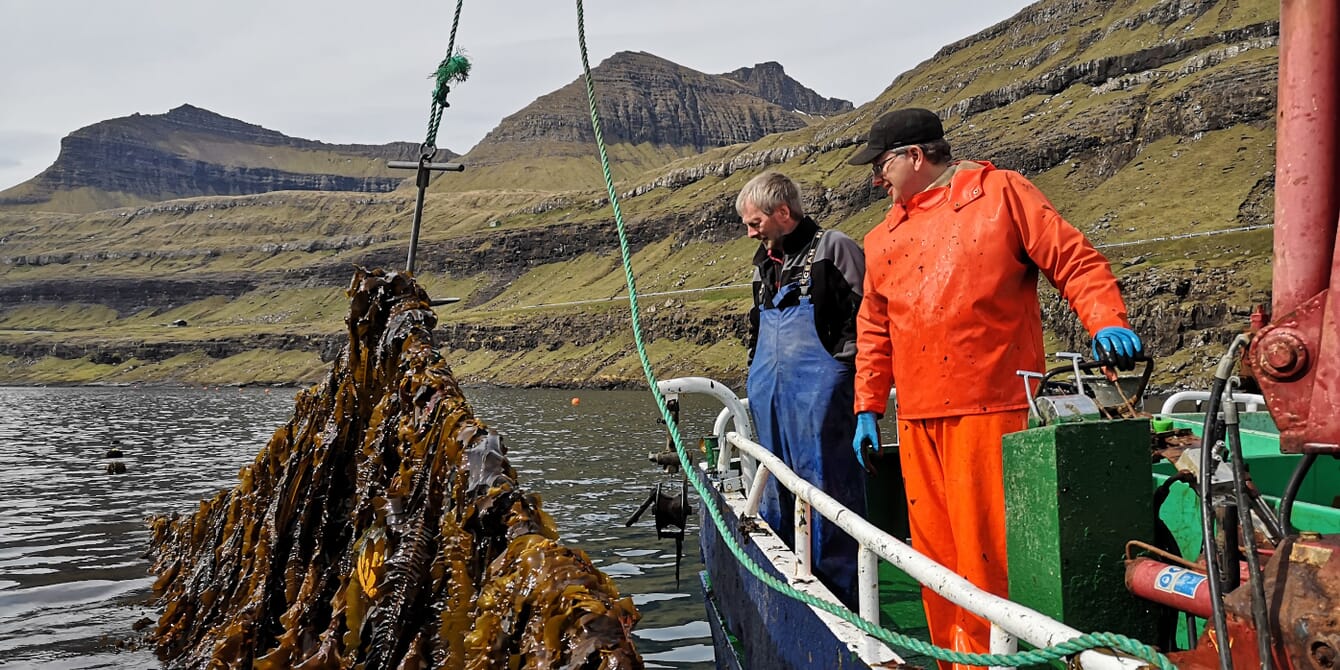
© Harald Bjorgvin
An accelerator and investment firm focused on the ocean, Katapult Ocean is one of the leaders in private investment into aquaculture, with 80 investments into the ocean space, including 10 to 15 in aquaculture specifically. Bellafiore, who focuses on the fund’s early-stage investments, explains their outlook.
Katapult’s seaweed investments include some of the biggest names in seaweed, like Ocean Rainforest, Carbonwave and Algaeing. Which seaweed investments are exciting right now?
We're very well-exposed to the seaweed sector in general. I don't know if there's one particular category that's more exciting than others, but we are seeing more adoption in the biostimulants sector. A lot of trials have shown that you can get increased yields from utilising seaweed-based biostimulants as a replacement for fertilisers, which is driving adoption. There’s plentiful supply of Sargassum and other types of seaweed which you can use to create these biostimulants, so the economics makes sense for scaling.
We’re also keeping an eye on bioplastics. In the EU there are regulations coming through now which will drive more adoption of biomaterials. However, the costs still need to come down in the bioplastics sector; they need to be at parity or close to parity with traditional fossil-based plastics in order for them to be adopted at scale.
For biostimulants, that sounds like it would be more like harvesting seaweeds rather than growing them. There is a big Sargassum problem in the Caribbean right now.
Sargassum is really a key one here, because you can build business models around it that kill two birds with one stone. First, you can clean up the Sargassum, which is off-gassing methane on beaches where it washes ashore. Not only does that solve a big climate issue, it also solves a big issue for the resorts because it doesn't smell very good and they want it off their beaches. Fundamentally, it hurts tourism, so they'll pay for people to remove it. If then, the company which collects it can turn around and put it through a biorefining process, creating sustainable commodities like biostimulants, which solve other climate issues,it's really a win-win.
In the Americas, there has been a huge drop off in funding for seaweed. Analysts are calling it “the seaweed winter”. Does Katapult see seaweed as an impact investment rather than one with money making potential? And if so, how long is Katapult prepared to continue invest into seaweed without returns?
I hadn't heard the term seaweed winter before you asked it in this question. It's not something that we're too worried about.
I do think that seaweeds have historically been viewed as an impact-first investment, due to their potential for carbon sequestering, ocean restoration, sustainable food production, etc. But as we’ve discussed there are applications in utilizing seaweed as a commodity which can be very profitable in biomaterials, biostimulants, and certainly in the food production sector, although there's been some contraction there.
We don't see a fundamental decline in potential returns in the sector, so we'll certainly still be looking to invest in good companies in the space and to support our portfolio companies in the space as they continue to grow.
Do you have a timeline on that?
AB:I don't think that's something that we've discussed internally in terms of setting a hard date on whether we'd stop making investments into the sector if we don't see returns. That said, we certainly are cognisant that the companies that we're investing in need to perform well for us to continue having interest in the space.

© Katapult Ocean
Do you see sny promising companies working to make fish farming more efficient, either with feed or technology?
We see the most interest on the feed side of things. We've invested quite a bit in companies that are trying to replace fishmeal. It takes about three tonnes of forage fish to feed one tonne of salmon. That is not an equation that's sustainable in the long term.
We are seeing lots of innovation in feed alternatives. There are companies working with insect meals and other organic ingredients and companies working with mycelium - a type of fast-growing fungi - to do that replacement, which are all very interesting.
The challenge remains scalability and unit economics. Aquaculture is, by definition, a very low margin, high efficiency and high volume business. You need to be able to produce those alternative feeds at scale, and similar to the conversation we're having around bioplastics, they need to be very close to, or at parity with, fishmeal or whatever you're replacing as the protein in the overall fish feed.
Additionally, while it is still quite early, we see an interest developing in the multi-trophic aquaculture space. Research and data shows if you grow things like seaweeds adjacent to aquaculture, integrated into the aquaculture operation, it improves water quality and improves fish health. There's untapped potential in that field. But again, it comes down to economics.
Where else in aquaculture should entrepreneurs be targeting their efforts in developing businesses?
In addition to what I just mentioned, we see a lot of potential in automation and sensing systems. I wouldn't call that space necessarily under-developed, but probably underutilised by a lot of aquaculture farms. And that's again because in aquaculture you need to be able to prove on a large scale that you’re able to improve the bottom line of these operations before those technologies get adopted.
What role do you see AI playing in sustainable aquaculture?
I don't think we've seen a lot of applications of AI in sustainable aquaculture to date. It might be pretty early in the AI-timeline.
When it comes to large data sets, if there are ways that AI can optimise aquaculture operations in some way, then that could be powerful. But again, it comes down to being able to prove the economics by utilising some type of AI analysis. Where we do see a lot of potential is in allowing things like AI, enabled by machine vision, to identify threats to aquaculture operations before farmers can. For instance, if there is a harmful algal bloom beginning - something which causes huge losses in aquaculture each year - AI could potentially provide advance warning to farmers, allowing them to intervene and minimize fishkill.

© Coral Vita
Can you explain a bit about your investments into restoring coral reefs?
The challenge we've always seen with coral reef restoration projects is that they're difficult to monetise: you need some form of blended finance model to really get them off the ground.
Our largest investment is with Coral Vita. They're doing a lot of really interesting things when it comes to ecotourism, micro-fragmentation, and assisted evolution of the coral reef species, which makes their particular method of coral restoration more economically viable. Essentially, they speed up the growth of the coral and then they also are able to assist in the corals’ development in a way that makes them more resilient. As they’re doing this, they work with different tourism entities such as cruise companies to allow people to come see this process, and they can also work with these same companies to sponsor restoration projects, which gives them a two-pronged revenue model.
Those types of advanced services are really important when it comes to coral reef restoration. Those are more sustainable, long-term projects that can have an outsized impact, as opposed to other projects which are going to be more difficult to scale. We don't exactly see the path to profitability for some of these companies that are more providing the structures which coral can grow on via, like 3D-printing or some other method, without adjusting the coral’s ability to survive or monetising their business in some other way.
Is there anything else on the horizon that you want to share?
I would double-down and say there’s still a lot of untapped potential in terms of seaweed. Your seaweed winter question threw me for a loop, because it's not something that we've heard. There are good opportunities in this space and I would caution investors from completely turning away from it.
Including for seaweed as food? In the US, there have been quite a few seaweed as food companies that closed.
There has is definitely been a contraction there. but I think seaweed as an ingredient within plant-based foods is just one application of seaweed as a commodity product.
I don't think people are going to en mass start eating kelp chips, necessarily. But I do think when you zoom out and look at seaweed as an industry, both microalgae and macroalgae are larger than just the food play. There are opportunities to utilise seaweed to replace incredibly harmful chemicals and plastics, as well as unsustainable ingredients in aquaculture and in other industries like pet food.
Moreover, there are other, more advanced applications for microalgae in particular, given its unique ability to produce things such as active pharmaceutical ingredients or cosmetic compounds. And because both macro and microalgae take far fewer resources to produce at scale, relatively speaking, than some other agricultural commodities, there is still a real chance for us to support a still burgeoning industry that could provide sustainable inputs to a variety of sectors. From an investment perspective, that still excites us.




